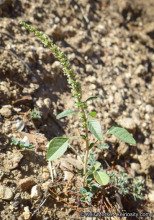Original native range is presumed to have been the southwestern United States to Texas and Mexico.
Amaranthus palmeri (Palmer's amaranth) is a dioecious, annual, flowering plant that is native to the southern United States. Its leaves, stems, and seeds were cultivated and eaten by Native Americans, however it is considered potentially toxic to livestock. Plants are mostly glabrous. Stems are erect with ascending branches, growing to 1 (rarely 2) m. Leaves have long petioles, with blades that are up to 10 cm long and rhombic-ovate to rhombic-lanceolate in shape. Inflorescences are linear spikes that are terminal and can be either erect or drooping, with small flowers. Seeds are dark reddish brown, small (1-1.2mm), and shiny. Palmer's amaranth is a serious weed of cotton and soybean crops and has developed resistance to multiple herbicides, including glyphosate, in parts of its range. It is wind-pollinated and its seed is easily transported by equipment and contaminated materials.
Palmer's amaranth was cultivated by Native Americans but is not currently bred or grown significantly as a crop.
